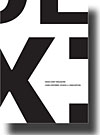INDEX: 2007 magazine and website on user-centered design and innovation
The theme is thoroughly examined during the Copenhagen Prelude Conference, the INDEX:|Aiga Aspen Design Summit and INDEX: SUMMER CAMP, as well as in the INDEX: publications.
An entire magazine is dedicated to this INDEX: 2007. You can download it here (pdf, 2.2 mb, 30 pages).
The general history and thinking behind User-centered Design & Innovation is introduced and juxtaposed against three different approaches that enable the reader to gain insight into the needs of users: The anthropology approach, the lead users approach and mass customisation, all three followed by instructive cases. In addition, user insight’s influence on the design of business models, services and strategies are explored.
In two interviews, Director at FORA and Chairman of INDEX: Jørgen Rosted sees User-centered Design & Innovation from a Danish perspective, and INDEX: Program Director Lise Vejse Klint explains how the 2007 sub theme fits into INDEX:’s main focus, Design to Improve Life.
The INDEX: knowledge base gives further insight on user-centered design themes. The INDEX: knowledge team has been down them all and has so far pinpointed 5 methods and 2 issues beyond traditional product design in the international landscape of design:
Introduction to user-centered design & innovation
User-centered design & innovation does not begin with the user; it begins with a vision: to offer better solutions to the market and thus have a better chance at success.Lead users
A Lead User faces needs that will be general for a wider population in time – but faces them months or even years before the rest of the population encounters them. Typically Lead Users therefore expect to benefit significantly by obtaining a solution to those needs. Lead Users can also be users of a given technology in adjacent industries, facing the same or similar problems, and therefore can be able to deliver technological solutions earlier. Lead Users are valuable in early determining future trends.Strategic Design
Strategic design sets a direction or profoundly reconfigures a client’s business to align them more closely with their markets. An acquisition or sell-off, creation of a new business, redesign of core business processes around customer segments, entry into new countries – these are all strategic decisions.Anthropology
Anthropology has gained a new relevance as human factors are recognized as increasingly important in design. Anthropologists, ethnographers and their like have entered a role of great importance to innovation and design as the role of the designer is divided into more specialized fractions. Using an anthropological approach is crucial to reveal tacit needs of the consumer.Mass Customisation
Mass customisation is a way of generating extra value by being flexible to customers, and at the same time keeping within manufacturing capability. Mass Customisation is introduced at a relatively late stage in the design process.Business model design
To engage the users early on is time consuming and often expensive as it is a premium cost to the in-house design and R&D departments, but to introduce the users at a late stage, can be even more expensive as significant changes perhaps need to be made, or perhaps there is no real interest in the innovation made. Making your entire business model user-centered can be a way of streamlining operations.Service design
Users cannot fail to notice if the service has been poorly designed. Perhaps even more than other kinds of design, service design really need to be user-centered.





Unfortunately the magazine PDF isn’t formatted for easy printing.
[…] Experientia crew have a nice overview of the INDEX:2007 event and publications that are tackling a variety of design and innovation […]